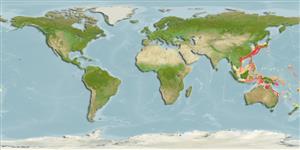Environment: milieu / climate zone / depth range / distribution range
Ökologie
seewasser demersal; tiefenbereich 65 - 278 m (Ref. 50734). Tropical
Western Pacific: Japan and Taiwan to New South Wales, Australia.
Size / Gewicht / Alter
Maturity: Lm ? range ? - ? cm
Max length : 19.0 cm TL Männchen/unbestimmt; (Ref. 9792)
Rückenflossenweichstrahlen (insgesamt) : 66 - 72; Afterflossenweichstrahlen: 51 - 57. Feebly pigmented snout, presence of supratemporal branch on lateral line of ocular side and medial dark pigmented spot on mandible and intermandibular area (Ref. 37532); lateral line on blind side absent; gill rakers on ocular side 3-6 + 7-13; caudal vertebrae 27-28; lateral-line scales on the ocular side 59-68; D 68-73, A 52-57, pectoral-fin rays on ocular side 8-10; caudal-fin rays 16-17; large ocelli on ocular side; pectoral-fin plain black or pale with black spots (Ref. 122002).
Found in the sublittoral zone on sandy mud bottoms (Ref. 11230). Rare. Feeds on small benthic animals.
Life cycle and mating behavior
Maturities | Fortpflanzung | Spawnings | Egg(s) | Fecundities | Larven
Hensley, D.A., 1997. Pleuronectidae. Righteye flounders. In K.E. Carpenter and V. Niem (eds.) FAO Identification Guide for Fishery Purposes. The Western Central Pacific. (Ref. 9792)
IUCN Rote Liste Status (Ref. 130435)
Bedrohung für Menschen
Harmless
Nutzung durch Menschen
Fischereien: nicht kommerziell
Tools
Zusatzinformationen
Download XML
Internet Quellen
Estimates based on models
Preferred temperature (Ref.
123201): 11.1 - 26.4, mean 19.2 °C (based on 172 cells).
Phylogenetic diversity index (Ref.
82804): PD
50 = 0.6250 [Uniqueness, from 0.5 = low to 2.0 = high].
Bayesian length-weight: a=0.01622 (0.00604 - 0.04358), b=2.94 (2.71 - 3.17), in cm total length, based on LWR estimates for this (Sub)family-body shape (Ref.
93245).
Trophic level (Ref.
69278): 3.5 ±0.37 se; based on food items.
Fishing Vulnerability (Ref.
59153): Low vulnerability (10 of 100).
